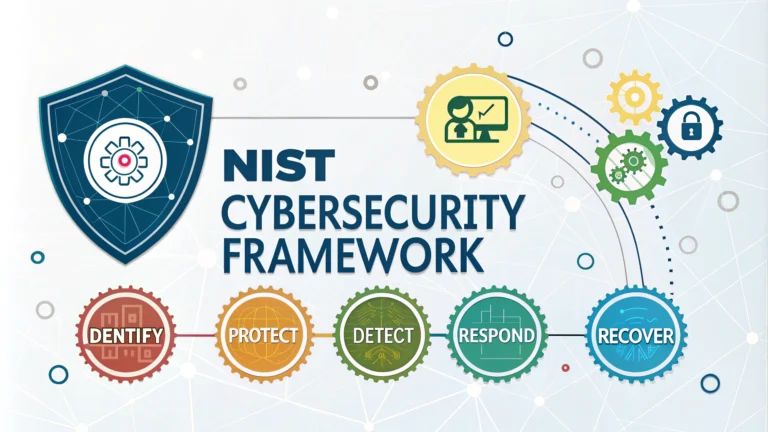The NIST Cybersecurity Framework provides structured guidance for organizations to better manage and reduce cybersecurity risk, with penetration testing playing a key role in its implementation.
Penetration testing within the NIST framework helps organizations identify vulnerabilities and assess their security posture through controlled cyber attacks.
This article explains how to effectively integrate penetration testing into your NIST Cybersecurity Framework implementation.
Core Components of NIST Penetration Testing
- Identify: Mapping assets and systems for testing
- Protect: Testing protective measures and controls
- Detect: Evaluating detection capabilities
- Respond: Testing incident response procedures
- Recover: Assessing recovery mechanisms
Types of Penetration Tests under NIST
- External Network Testing: Assessing external-facing assets
- Internal Network Testing: Evaluating internal systems
- Web Application Testing: Testing web-based applications
- Wireless Network Testing: Checking wireless infrastructure
- Social Engineering: Testing human elements
Implementation Steps
- Define scope and objectives aligned with NIST requirements
- Select qualified penetration testing providers
- Establish testing parameters and boundaries
- Execute tests according to NIST guidelines
- Document and analyze results
- Implement remediation measures
Best Practices for NIST-Aligned Penetration Testing
- Schedule regular testing intervals (quarterly or bi-annual)
- Maintain detailed documentation of all tests
- Use both automated and manual testing methods
- Follow ethical hacking principles
- Ensure proper authorization before testing
Common Tools and Resources
| Tool Type | Examples |
|---|---|
| Vulnerability Scanners | Nessus, OpenVAS, Qualys |
| Exploitation Frameworks | Metasploit, Core Impact |
| Network Analysis | Wireshark, Tcpdump |
Reporting and Documentation Requirements
- Executive summary for stakeholders
- Technical findings and evidence
- Risk ratings for vulnerabilities
- Remediation recommendations
- Compliance alignment status
Moving Forward with Your Security Program
Regular updates to your penetration testing program ensure alignment with evolving NIST framework requirements and emerging threats.
Contact the NIST Cybersecurity Framework team for additional guidance on framework implementation.
Schedule quarterly reviews of your penetration testing program to maintain effectiveness and compliance with NIST standards.
Testing Documentation and Tracking
- Maintain comprehensive test logs
- Track remediation progress
- Document exceptions and compensating controls
- Record test coverage metrics
- Archive historical testing data
Integration with Risk Management
Risk Assessment Alignment
- Map penetration test findings to risk registers
- Prioritize vulnerabilities based on business impact
- Integrate results into risk management frameworks
- Update threat models with new findings
Continuous Monitoring
- Implement ongoing vulnerability scanning
- Monitor security control effectiveness
- Track security metrics and KPIs
- Assess emerging threats
Stakeholder Communication
- Regular briefings with executive leadership
- Technical debriefs with IT teams
- Status updates to compliance officers
- Coordination with third-party vendors
- Communication with regulatory bodies
Strengthening Your Security Posture
Establish a continuous improvement cycle by leveraging penetration testing insights to enhance your security controls and incident response capabilities.
Regularly assess the effectiveness of your testing program against NIST framework updates and industry best practices.
Build a security-aware culture that embraces penetration testing as a critical component of your organization’s cybersecurity strategy.
FAQs
- What role does penetration testing play in the NIST Cybersecurity Framework?
Penetration testing is a key component of the NIST CSF’s “Detect” and “Identify” functions, helping organizations discover vulnerabilities, assess security controls, and validate security measures before attackers can exploit them. - How frequently should penetration testing be performed under NIST guidelines?
NIST recommends conducting penetration tests at least annually, or whenever significant changes occur in the infrastructure, applications, or security controls. - What are the main types of penetration testing aligned with NIST CSF?
The main types include external network testing, internal network testing, web application testing, wireless network testing, social engineering testing, and physical security testing. - How does NIST CSF differentiate between vulnerability scanning and penetration testing?
Vulnerability scanning is automated and identifies known vulnerabilities, while penetration testing involves active exploitation attempts by skilled professionals to validate security controls and discover complex security weaknesses. - What qualifications should penetration testers have according to NIST?
NIST recommends penetration testers possess industry-recognized certifications (like CEH, OSCP), relevant experience, and understanding of both offensive security techniques and defensive controls. - How should penetration test results be integrated into the NIST CSF implementation?
Results should be documented in detailed reports, prioritized based on risk, integrated into the risk assessment process, and used to update security controls and policies within the framework’s continuous improvement cycle. - What are the key components of a NIST-compliant penetration testing report?
The report must include an executive summary, methodology, detailed findings, risk ratings, technical details of vulnerabilities, proof of exploitation, and specific remediation recommendations. - How does penetration testing support the NIST CSF’s five core functions?
Penetration testing supports Identify (discovering assets and vulnerabilities), Protect (validating security controls), Detect (testing detection capabilities), Respond (validating incident response procedures), and Recover (testing backup and recovery processes). - What are the scope considerations for NIST-aligned penetration testing?
The scope should include critical assets identified in the framework implementation, business-critical systems, external-facing services, and systems that process sensitive data. - How should organizations handle critical vulnerabilities discovered during penetration testing?
Critical vulnerabilities must be addressed immediately, documented in the risk register, and remediated according to the organization’s incident response and risk management procedures as defined in the NIST CSF.







